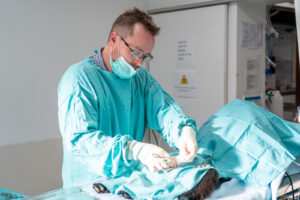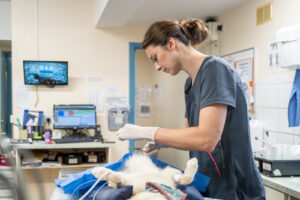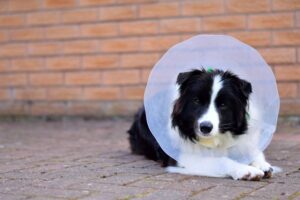Updated: 12/05/25
Neutering is an operation that prevents dogs from being able to reproduce. The question of whether and when to neuter your dog can be a complex one. Your vet will be happy to offer advice on the best plan for your dog based on their individual situation.
Neutering is usually a straightforward operation with a smooth recovery. Female dogs don’t need to have had a litter before being neutered. The temperament, health status and behaviour of male dogs should be considered before deciding to castrate them.
Neutering can alter energy requirements, so dogs may need their diets altered afterwards to stay at an appropriate body weight.
To book an appointment or learn more about neutering, please contact your veterinary practice.
On this page:
- What is neutering?
- How does neutering prevent my dog from having puppies?
- When should I get my dog neutered?
- What are the benefits to having my dog neutered?
- What happens when my dog is neutered?
- How long will it take my dog to recover from being neutered?
- Commonly asked questions
- Useful resources
What is neutering?
The term ‘neutering’ refers to an operation that is done to prevent a dog from being able to reproduce. This is often referred to as a ‘castration’ in males (dogs) and a ‘spay’ in females (bitches). Sometimes it is called ‘sterilisation’.
How does neutering prevent my dog from having puppies?
Neutering a dog is a surgical procedure to take away their reproductive capability and stop them having puppies.
In male dogs, both testicles are removed, which removes their testosterone (and drive to pursue unneutered female dogs!), but it also means they no longer have the sperm to father puppies.
When female dogs are neutered, either their ovaries (ovariectomy) or the ovaries and womb (ovariohysterectomy) are removed. This means she will no longer have ‘seasons’ and can’t have puppies.
Whether an ovariectomy or ovariohysterectomy is done will often depend on the vet performing the operation and your dog’s individual circumstances.
These procedures take away your dog’s ability to conceive and carry puppies.
When should I get my dog neutered?
The question of whether and when to neuter your dog can be a complex one. Some dogs can be neutered from six months of age, but for others, it may be more appropriate to delay neutering until they are older. You are always best to follow the advice of your vet.
A dog’s weight and current health will also affect the best time to book them in for neutering.
Overweight dogs will often be recommended to follow a weight loss plan before surgery to make their operation safer.
For female dogs, their operation will need to be timed around their seasons (ideally two to three months after a season) to make the surgery safer.
For male dogs, their temperament and behaviour will need to be fully considered (as neutering can potentially make certain behaviours worse).
If there is any doubt, it is best to discuss this with your vet or vet nurse prior to surgery and, if advised, consider referral to a certified animal behaviourist first.
These are all factors to discuss with your vet, so that you can make the best decision for your dog based on their specific situation.

What are the benefits to having my dog neutered?
There are many benefits to neutering dogs when appropriate to do so.
For many dogs, neutering reduces a number of health risks, examples of which are outlined below.
Male dogs who aren’t neutered are at increased risk of:
- Testicular cancers.
- Roaming to find female dogs (and therefore getting lost or injured).
- Unwanted behaviours such as humping (although humping is not always sexually driven).
- Castration may also possibly alter the risk of prostate disease and perianal tumours and hernias.
Female dogs who aren’t neutered are at increased risk of:
- Mammary (breast) tumours.
- Womb infections (pyometra).
- Unwanted pregnancies.
- Issues associated with false pregnancies (e.g. going off food, restlessness).
- Issues associated with seasons (e.g. behavioural changes if part of a multi-dog household).
- Unwanted behaviours such as humping (although humping is not always sexually driven).
Other things to think about:
Coat changes
For some breeds of dog their coat may change, for example, become more fluffy post-neutering.
Weight gain
Neutering itself does not make your dog overweight. However, it can alter your dog’s metabolism, meaning their calorie requirement may be less to maintain a healthy weight.
There are two options to combat this. One is to reduce their daily food a little to account for this. The other option is to switch to a food formulated for neutered dogs, which is likely to allow for better calorie control.
You can ask your veterinary team for further advice on this.
Urinary incontinence (leaking wee)
Urinary incontinence is a medical condition where your dog unintentionally leaks urine (wee).
Any female dog can suffer from incontinence. However, the risk of incontinence can increase after spaying due to decreased hormone levels.
The risk is still low, and urinary incontinence can usually be managed with medication.
Some breeds are thought to be at a higher risk of urinary incontinence than others. If this is something you are concerned about, speak to your vet for advice.

What happens when my dog is neutered?
If your dog is booked in to be neutered, they will visit the veterinary practice as a day patient.
They will often be admitted in the morning and as for a human operation, you will usually have been asked to not feed them overnight and to withhold their breakfast.
When you drop your dog off, a member of the veterinary team will talk you through what will happen and ask you to sign a consent form. You will also have the chance to ask any questions.
No anaesthetic is completely risk free, but modern veterinary medicine means that routine procedures such as neutering are generally very safe.
Your dog will then be taken through onto the ward, be weighed and have a check over prior to their operation.
All dogs are neutered under a general anaesthetic. This means your dog is deeply asleep for the procedure and unable to feel any pain.
Depending on whether your dog is having a blood test taken, they may have a clipped patch under their neck in addition to a clipped patch on one or both front legs from where the anaesthetic medication has been given.
When male dogs are neutered a patch of fur is clipped at the base of the penis and the area is cleaned, a small cut is then made vertically just above the scrotum and each testicle is removed via this one hole.
The skin and underlying tissue are then closed with stitches.
If a dog has a retained testicle, this procedure can become a little more complicated and this is something your vet would discuss with you prior to the procedure.

When female dogs are neutered, the fur is clipped on the underside of their tummy and the area is cleaned for surgery.
A cut is made through the skin and muscle to open the abdomen.
Either the ovaries (ovariectomy) or the ovaries and womb (ovariohysterectomy) are removed.
Which option will be decided by the preference of your vet and other factors, for example, whether your dog has a womb infection. The muscle and skin are then closed with stitches.
Some vets offer keyhole (laparoscopic) neutering for female dogs, which involves two to three small cuts through the skin and muscle. Only the ovaries are removed, and dogs are reported to have faster recoveries.

Pain relief is given before the operation so that it will already be working when the anaesthetic has worn off.
A nurse will monitor your dog while they wake up and once ready, will offer them some bland food. Most dogs will be allowed home on the same day.
When you collect your dog, you will be advised on whether they need a buster collar or medical t-shirt to protect their wound, what pain relief they have had and need, what you should feed them, instructions for resting them and when they need to have a follow-up appointment.
As with any surgical procedure, complications are possible as the wound heals, and it is important that you monitor the wound and your dog’s general health and let your veterinary team know if you have any concerns.
It’s also important to follow the recovery advice you have been given carefully.

How long will it take my dog to recover from being neutered?
Dogs tend to recover quite quickly from being neutered, although females often take longer to feel better than males.
Most are feeling back to themselves within a few days and completely recovered after 10 days.
Regardless of how bright your dog seems, it is important to strictly rest them until signed off by your veterinary team, as the surgical wound takes time to heal and allowing them to exercise can cause complications.
Other commonly asked questions
Why does my dog need a buster collar or medical t-shirt/bodysuit after their surgery?
Keeping your dog’s surgical wound clean and dry is vital to ensure a smooth recovery post-surgery. If your dog can lick their wound, this will slow the healing process and greatly increase the risk of post-operative complications including infections, or in severe cases, the need for a second surgery to re-close the wound.
Using a buster collar or medical t-shirt is the best way of protecting the area from your dog and supporting their recovery.
What complications might my dog experience during recovery at home?
Most dogs have smooth recoveries after being neutered, and many can be signed off after about 10 days. For those that experiences complications, these can include:
- Mild irritation where the surrounding fur has been clipped for surgery (‘clipper rash’).
- Infections in the surgical wound – this is often associated with the wound getting wet, dirty or being licked by the dog.
- Wound breakdown – this is where the wound fails to heal normally and may start to open. This is often associated with infections or the dog over-exerting during the recovery period. It is very important that your dog is strictly rested so the wound can heal properly.
- Reaction to the stitches under the skin – this can cause mild swelling and or raised areas along the wound.
It is generally sensible to monitor that your dog is eating, drinking and toileting okay and that they don’t seem excessively quiet or out of sorts.
When checking your dog’s wound, it should be clean and dry, with no signs of redness, stickiness (discharge) or swelling.
If you notice anything that worries you, or you feel the wound has suddenly changed in appearance, then reach out to your veterinary team for support ahead of the scheduled post-operative checks.
What’s chemical castration?
It is possible to use hormonal implants in male dogs to mimic the effect of castrating them.
The hormones in these implants make your dog infertile for a short period of time (often six to 12 months) before wearing off.
Chemical castration offers the opportunity to assess what effect castration would have on your dog, in a reversible way. You can speak to your vet to learn more about this.
What is a ‘season’?
Female dogs (bitches) start to have ‘seasons’ or come into ‘heat’ once they reach puberty. Many bitches start to have seasons at around six months old and have them twice a year from then on, but this can vary between individuals and breeds.
During a season your dog’s vulva (genitals) will look swollen and pink and you will often see a blood-tinged vaginal discharge.
Your dog can become pregnant if mated during a season or immediately after it.
During this time, she will become very interesting to male dogs, so do not let her off the lead if you take her for a walk and avoid places where there are dogs running loose.
You will usually be asked to wait about three months after your dogs’ season before booking her in to be neutered.
This allows blood vessels around the womb to reduce, which makes the surgery safer. Your vet will be able to advise on the best timings for your dog’s surgery.
Does my female dog need to have a litter before she is neutered?
It is a myth that dogs need to have a litter of puppies before being spayed. There are no health or behavioural benefits to your dog having a litter before you get her spayed.
If you have any further questions about neutering your dog or would like to book them in for this procedure, please contact your local veterinary practice for further support.
Useful resources:
- PDSA – Dog neutering – A guide to castration and spaying
- Blue Cross – Neutering your dog
- Dogs Trust – Why neuter your dog?
Did you find this article useful? You may also like:
- A Complete Guide to Microchipping Your Dog
- Vaccinating Your Dog A Complete Guide
- How Much Do You Know About Fleas and Your Dog?
- Does My Dog Need Pet Insurance?

